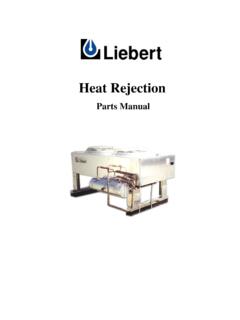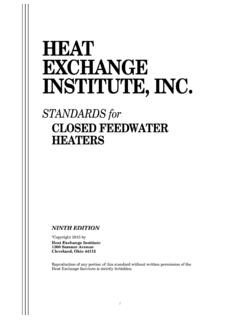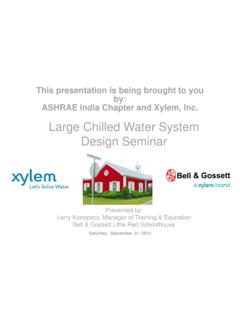Transcription of Air-Cooled Heat Exchangers and Cooling Towers
1 UNESCO EOLSSSAMPLE CHAPTERSTHERMAL POWER PLANTS Vol. III - Air-Cooled heat Exchangers and Cooling Towers - Kr ger Encyclopedia of Life Support Systems (EOLSS) Air-Cooled heat Exchangers AND Cooling Towers Kr ger Department of Mechanical Engineering, University of Stellenbosch, South Africa Keywords: Cooling Towers , Wet Cooling , Dry Cooling , Air-Cooled heat Exchangers , Hybrid Cooling Systems Contents 1. Introduction 2. Cooling Towers Mechanical Draft Natural Draft 3. Air-Cooled heat Exchangers Mechanical Draft Natural Draft 4. Dry/wet and wet/dry Cooling Systems Glossary Bibliography Biographical Sketch Summary In all power plants a large amount of heat has to be rejected in order to sustain the thermodynamic cycle.
2 In all steam cycles this heat is rejected via the condenser in which the exhaust steam from the turbine is condensed before being returned as feedwater to the boiler. The heat released in the condenser must be rejected to the environment. In regions lacking large bodies of water this rejection must be to the atmosphere. The requirement for a small temperature difference between the exhaust steam and the atmosphere, while rejecting large quantities of heat to air having a low heat capacity compared with water, poses a challenging technological problem which has resulted in a number of different engineering solutions. To ensure that condensation of the steam will occur under low temperature, and hence high vacuum conditions while maintaining it free from contamination, requires at least one solid boundary where heat transfer is governed primarily by convection.
3 Evaporative Cooling , however, is very attractive in reducing the overall temperature difference between the exhaust steam and the atmosphere and is used wherever there is an adequate supply of water. In arid regions however this may not be an option due to lack of water and dry Cooling systems have to be adopted. Indirect dry Cooling systems have an intermediate closed Cooling water circuit while direct systems have the steam condensed directly by the air flow. Air flow through the Cooling elements may be naturally induced by tall Cooling Towers or forced by large fans. The latter provide a more compact arrangement but involve higher operating costs. UNESCO EOLSSSAMPLE CHAPTERSTHERMAL POWER PLANTS Vol.
4 III - Air-Cooled heat Exchangers and Cooling Towers - Kr ger Encyclopedia of Life Support Systems (EOLSS) Operational performance varies with ambient atmospheric conditions. To maintain the specified exhaust steam temperature and pressure may require derating of the unit under high ambient temperature conditions since the heat rejected varies with the temperature difference between the steam and the air. For dry Cooling systems the performance can be enhanced by partial evaporative Cooling under high ambient temperatures. This gives rise to hybrid wet and dry Cooling systems utilized in several applications. 1. Introduction In any power generating or refrigeration cycle, heat has to be discharged.
5 This is also true in many chemical and process plant cycles, internal combustion engines, computers and electronic systems. The efficiency of a modern automobile engine is such that most of the energy contained in the fuel is rejected through the exhaust and the radiator. In a fossil-fired power plant with an efficiency of about 40 percent, more than 40 percent of the heat input has to be rejected through the Cooling system. Even more heat has to be rejected in less efficient nuclear power plants. Considerably less heat is rejected in a modern combined cycle power plant. The hydrosphere has in the past been the commonly used heat sink at industrial plants. The simplest and cheapest Cooling method was to direct water from a river, dam or ocean to a plant heat exchanger and to return it, heated, to its source.
6 In industrialized countries, the permissible rise in temperature of such Cooling water is often limited, thus limiting the use of natural water for once-through Cooling . The task of choosing the source of Cooling for large industrial plants is becoming increasingly complex. Dwindling supplies of Cooling water and adequate plant sites, rapidly rising water costs usually at well beyond inflation rates in most industrialized countries, noise restrictions and other environmental considerations and proliferating legislation, all contribute to the complexity. Because of restrictions on thermal discharges to natural bodies of water, most new units of power generation or large industries, will have to make use of closed cycle Cooling systems.
7 Evaporative- or wet- Cooling systems ( Cooling Towers ) generally are the most economical choice for closed cycle Cooling where an adequate supply of suitable water is available at a reasonable cost to meet the make-up water requirements of these systems. Unfortunately, many Cooling Towers have in the past failed to meet design specifications, in part due to outdated design methods. Air-Cooled heat Exchangers are found in the electronics industry, vehicles, air conditioning and refrigeration plants and in chemical and process plants where fluids at temperatures of approximately 60 C or higher are to be cooled . The use of Air-Cooled or dry- Cooling systems in industry or in power plants is often justified where Cooling water is not available or is very expensive.
8 In certain applications dry/wet or wet/dry Cooling systems offer the best option. An appropriate and well-designed Cooling system can have a very significant positive impact on plant profitability. UNESCO EOLSSSAMPLE CHAPTERSTHERMAL POWER PLANTS Vol. III - Air-Cooled heat Exchangers and Cooling Towers - Kr ger Encyclopedia of Life Support Systems (EOLSS) 2. Cooling Towers The development, practice, and performance of evaporative Cooling systems or Cooling Towers have been described in numerous publications including some of those listed in the Bibliography. A Cooling tower is a device that uses a combination of heat and mass transfer to cool water. The water to be cooled is distributed in the tower by spray nozzles, splash bars, or film fill in a manner that exposes a very large water surface to atmospheric air.
9 The movement of the air is accomplished by fans (mechanical draft), natural draft or the induction effect from water sprays. A portion of the water is evaporated because the moisture content of the air is less than saturated at the temperature of the water. Since this process of evaporation requires energy to change the water from liquid to vapor, the water is cooled . Figure 1: Mechanical draft Cooling tower installed in a power plant. Figure 1 shows a typical Cooling circuit at a power plant. Turbine exhaust steam condenses in a surface condenser where heat is given up to the Cooling water circulating through the condenser tubes.
10 The hot water leaving the condenser is piped to the Cooling tower distribution basin from where it flows downward through the fill or packing which serves to break the water up into small droplets or spreads it into a thin film in order to maximize the surface contact between the water and the Cooling air which is drawn through the fill by the axial flow fan. The water, after being cooled by a combination of evaporation and convective heat transfer, is again pumped through the condenser in a continuous closed circuit. One to three percent of the circulating water is lost due to evaporation. UNESCO EOLSSSAMPLE CHAPTERSTHERMAL POWER PLANTS Vol.














